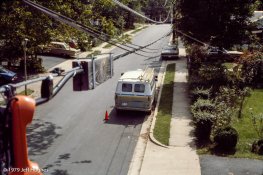I loved Kodachrome, but completely understand why the markeplace could not support it forever.
I shot 118 rolls of Kodachrome products, starting with a 126 Kodapak of Kodachrome-X in 1973, ending in 2010 with a 12-year old roll of frozen Kodachrome 25 that actually delivered superb results (in all, 19 ciné, 30 stereo, and 69 rolls of 2D slides).
I actually stopped using Kodachrome and went back to it later. I did have one real complaint about Kodachrome: While it gave beautiful images when it worked right, more than a few rolls would be plagued by a combination of low color saturation and a color cast - either aqua green or brownish magenta. I don't know if this was because of variation in the film, the storage, or the processing of the film, I do know the problem became worse with time.
After my stereos of our honeymoon came back dull green, I completely jumped to Fujichrome 100. In 2000, I started shooting Kodachrome 64 again for the strangest reason**, though I continued to use Fuji in other cameras. Oddly, for the first years of this century, I found KR64 was reliably giving good color again. This was when the slides came back from Kodak with the "MN12" stamp (Lerner Minneapolis, I believe).
Substantive reversal films definitely improved over the years, to the detriment of Kodachrome. Many people point to Velvia as the "Kodachrome killer", But I always thought that Fujichrome Sensia 100 (RD, circa 1994) had a huge impact. Years before, there were E-6 films that delivered saturated color (Ektachrome-X, Fujichrome 50 RF, and especially Velvia), but none delivered deep, dense color like Kodachrome - until Sensia 100, which looked just like Kodachrome on the light table. When Sensia 100 RD was replaced with Sensia 100 RA (1997) and I noticed the warmer color balance and teal shifted to kelly green, I stocked up RD Sensia.
Kodachrome was really hit harder by cultural and demographic shifts than by other slide films. Much of the Kodachrome business was home movie film, but demand for home movies fell in the 60s and 70s, in fact, decimated well before the first home camcorder hit the market, and Kodachrome leaned to home movies more than E-6 films did, With other lifestyle changes, fewer people were using slide films of any kind, especially as C-41 and RA-4 approached cost parity with slides. Then digital cameras slashed the demand for photographic film in general. The combination killed Kodachrome off.
More questions for PE:
At one time, the Kodak website actually mentioned Kodachrome 100 film (amusingly, to announce that it was Y2K compliant!), but was there ever any Kodachrome 100? (I may mention here that the lack of an ISO 100 product probably hurt Kodachrome in the marketplace)
I never knew that a Kodachrome 400 had ever been under development. Why was it never released?
I was really surprised that samples of an ISO 120 Kodachrome had ever been produced. Would it not haven been ISO 125?
I was quite impressed when I used Ektachrome Lumiere 100 (LPP), but it was only on the market for about a year. What led to its downfall?
Is there any table published anywhere that shows statistics of how many rolls of different film products were produced year-over-year?
What year did sales of Kodachrome products peak?
** I had bought an Olympus Stylus Epic (AKA mju) to carry with me and take quick and easy slides on the fly, but noticed that it tended to produce underexposed slides with Sensia 100. Knowing that the DX reader on the Stylus Epic read any film with an ISO of 50, 64 or 80 as ISO 50, I figured using KR64 would give of 1/3 stop more exposure, and it worked.





